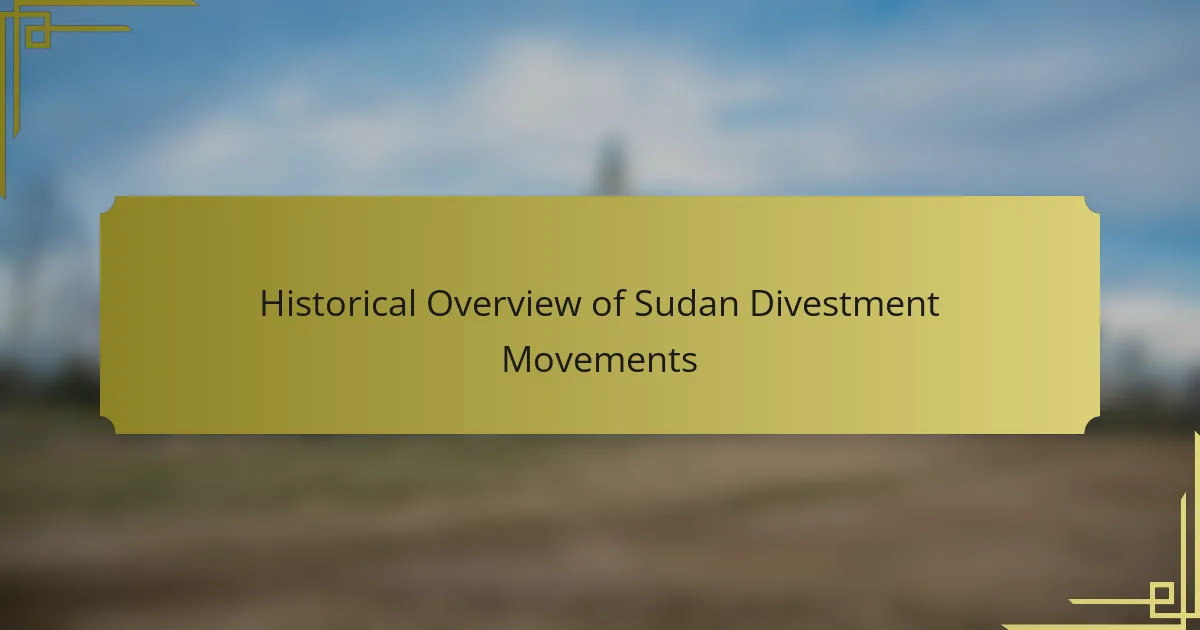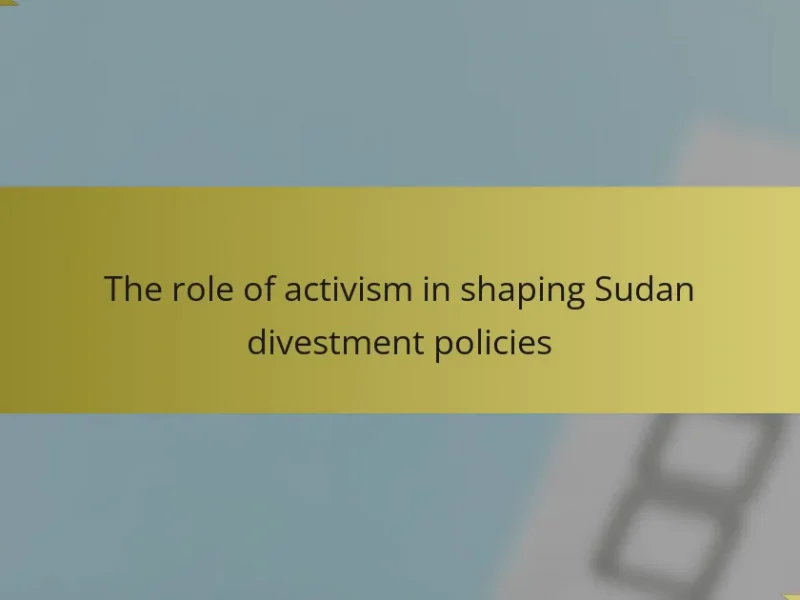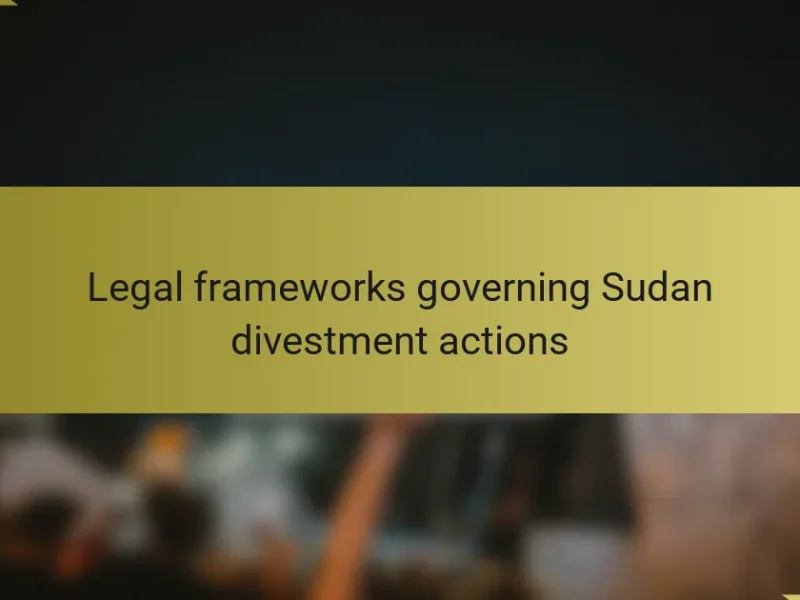The Sudan divestment movements emerged in the early 2000s as a response to the humanitarian crisis in Sudan, particularly during the Darfur conflict, characterized by genocide and human rights abuses by the Sudanese government. Activists and organizations aimed to pressure corporations and institutional investors to withdraw support from Sudan, drawing parallels to the anti-apartheid movement in South Africa. Key strategies included grassroots mobilization, public awareness campaigns, coalition-building, and legal actions, which collectively influenced significant financial divestments from Sudanese interests. These movements not only raised awareness about the crisis but also contributed to legislative actions and fostered international dialogue on corporate responsibility in conflict zones. Overall, the Sudan divestment movements played a vital role in shaping public perception and policy regarding human rights in Sudan.
The Sudan divestment movements emerged in response to severe human rights abuses in Sudan, particularly during the Darfur conflict. Beginning in the early 2000s, activists and organizations advocated for divestment from companies supporting the Sudanese government, gaining traction as reports of genocide surfaced. Key strategies included targeting institutional investments, mobilizing public awareness through campaigns, pursuing legal accountability for complicit companies, and building coalitions among diverse advocacy groups. Despite facing challenges such as a lack of international consensus and resistance from profit-driven companies, the movements aimed to create economic repercussions for the Sudanese government’s actions.

What are the Historical Roots of Sudan Divestment Movements?
Sudan divestment movements originated in response to human rights abuses in Sudan, particularly during the Darfur conflict. Activists and organizations began advocating for divestment from companies supporting the Sudanese government in the early 2000s. The movement gained momentum as reports of genocide and ethnic cleansing emerged. Notable campaigns included efforts led by organizations like the Sudan Divestment Task Force. These campaigns aimed to pressure corporations and universities to withdraw investments in Sudan. By 2006, several states and universities had enacted divestment measures. The historical roots are deeply intertwined with global awareness of Sudan’s humanitarian crises and the call for ethical investment practices.
How did the early divestment movements in Sudan begin?
The early divestment movements in Sudan began in the late 1990s. Activists targeted companies investing in Sudan due to the government’s involvement in human rights abuses. The Darfur conflict heightened awareness of these issues. Various organizations, including the Sudan Divestment Task Force, emerged to advocate for divestment. They aimed to pressure companies to withdraw investments. This movement gained traction on college campuses and among social justice groups. By 2006, several states and universities had enacted divestment policies. These actions were driven by a desire to hold the Sudanese government accountable for its actions.
What were the key events that sparked the initial divestment efforts?
The initial divestment efforts were sparked by the Sudanese government’s actions during the Second Sudanese Civil War. The conflict, which began in 1983, led to widespread human rights abuses and atrocities. Reports of genocide and ethnic cleansing in Darfur emerged in the early 2000s. In response, activists and organizations began advocating for divestment from companies operating in Sudan. The U.S. government imposed economic sanctions against Sudan in 1997, further motivating divestment initiatives. In 2005, the Sudan Divestment Task Force was established to coordinate these efforts. By 2007, several universities and institutions had committed to divesting from Sudanese interests. These events collectively fueled the momentum for divestment movements focused on Sudan.
Who were the main players involved in these early movements?
The main players involved in the early Sudan divestment movements included activists, non-governmental organizations (NGOs), and university students. Activists like Eric Cohen played a significant role in raising awareness. NGOs such as Save Darfur Coalition mobilized public support and resources. University students organized campaigns to pressure their institutions to divest from companies operating in Sudan. Additionally, state governments enacted divestment legislation. These efforts collectively aimed to address the humanitarian crisis in Sudan and promote ethical investment practices.
Why are divestment movements significant in the context of Sudan?
Divestment movements are significant in the context of Sudan because they aim to exert economic pressure on the Sudanese government. This pressure targets the regime’s funding sources, particularly in response to human rights abuses. In the early 2000s, activists highlighted the Sudanese government’s role in the Darfur conflict. They called for divestment from companies operating in Sudan, which was linked to violence and oppression. Major universities and pension funds began to withdraw investments. This collective action raised awareness globally and influenced policy changes. The divestment movement also aimed to promote ethical investment practices. By mobilizing public opinion, it sought to hold corporations accountable for their operations in conflict zones.
What impact have these movements had on Sudan’s economy?
The movements have significantly weakened Sudan’s economy. Economic sanctions and divestment campaigns have led to reduced foreign investment. This has resulted in a decline in GDP growth rates. The country’s oil revenues, a major economic driver, have also suffered. In 2011, Sudan lost about 75% of its oil production due to South Sudan’s independence. Inflation rates have soared, reaching over 300% in recent years. The movements have contributed to widespread unemployment and poverty. Overall, these factors have destabilized Sudan’s economic landscape.
How have divestment efforts influenced international relations with Sudan?
Divestment efforts have significantly influenced international relations with Sudan. These efforts often aimed to pressure the Sudanese government regarding human rights abuses and conflicts. Countries and organizations that divested sought to isolate Sudan diplomatically and economically. This isolation led to increased scrutiny of Sudan’s policies and actions on the global stage. For example, divestment campaigns in the early 2000s were linked to heightened awareness of the Darfur conflict. As a result, some nations imposed sanctions against Sudan. These sanctions further strained diplomatic relations. Over time, divestment contributed to a shift in international engagement strategies with Sudan.

What Strategies Have Been Used in Sudan Divestment Movements?
Sudan divestment movements have employed various strategies to exert economic pressure. One key strategy is the advocacy for institutional divestment from companies operating in Sudan. Organizations have targeted universities, pension funds, and religious institutions to withdraw investments. This approach aims to reduce financial support for the Sudanese government.
Public awareness campaigns have also been crucial. Activists have utilized social media and public demonstrations to highlight human rights abuses in Sudan. These campaigns often mobilize grassroots support and influence public opinion.
Additionally, legal strategies have been implemented. Lawsuits against companies complicit in human rights violations have been filed to hold them accountable. These legal actions serve to deter future investments in the region.
Coalition-building among various organizations has strengthened the movement. Diverse groups, including human rights organizations and faith-based groups, have united to amplify their message. This collaboration enhances the effectiveness of their advocacy efforts.
Finally, lobbying efforts have targeted policymakers. Advocates have sought to influence legislation that supports divestment and sanctions against the Sudanese government. These strategies collectively aim to create economic consequences for Sudan’s actions.
What are the common strategies employed in these movements?
Common strategies employed in Sudan divestment movements include advocacy, public awareness campaigns, and shareholder activism. Advocacy focuses on influencing policymakers to impose sanctions or divest from companies operating in Sudan. Public awareness campaigns aim to educate the public about the humanitarian crisis in Sudan, mobilizing grassroots support. Shareholder activism involves investors pressuring companies to withdraw investments in Sudan or adopt ethical practices. These strategies have been effective in raising awareness and prompting legislative action, as seen in the 2006 Sudan Accountability and Divestment Act in the United States.
How do grassroots campaigns contribute to divestment efforts?
Grassroots campaigns significantly contribute to divestment efforts by mobilizing community support and raising awareness. They engage local populations to advocate for ethical investment practices. These campaigns often highlight the negative impacts of investments in specific sectors, such as fossil fuels or oppressive regimes. For instance, grassroots movements have successfully pressured universities and institutions to divest from companies linked to human rights abuses. According to a report by the Global Divestment Movement, over 1,000 institutions have committed to divestment, driven largely by grassroots activism. Such campaigns create a collective voice that influences policymakers and investors alike. They utilize social media and public demonstrations to amplify their message and build momentum. Ultimately, grassroots campaigns serve as a catalyst for broader divestment initiatives, making them essential to the movement.
What role do social media and technology play in these strategies?
Social media and technology play a critical role in the strategies of Sudan divestment movements. They facilitate rapid information dissemination and mobilization of supporters. Platforms like Twitter and Facebook allow activists to share updates and organize events. Technology enables real-time communication among participants across different locations. Social media campaigns can raise awareness and amplify the voices of those affected by the situation in Sudan. Additionally, online petitions and crowdfunding have been effective in garnering financial support for divestment efforts. The use of data analytics helps organizations track engagement and assess the impact of their campaigns. Historical examples show that technology has enhanced the visibility of divestment movements, leading to increased pressure on corporations and policymakers.
How have corporations responded to divestment calls in Sudan?
Corporations have generally responded to divestment calls in Sudan by withdrawing investments or reducing their presence. Major companies, particularly in the oil and mining sectors, faced pressure from activists and human rights organizations. In 2007, for instance, companies like PetroChina and Total began to divest or limit operations due to public scrutiny. Reports indicated that divestment efforts aimed to pressure the Sudanese government regarding human rights abuses. Furthermore, some firms publicly announced their exit to align with ethical standards. This trend reflects a broader corporate response to social responsibility and activism surrounding Sudan’s political climate.
What are some notable examples of companies that divested?
Notable examples of companies that divested from Sudan include Siemens, Talisman Energy, and PetroChina. Siemens announced its divestment in 2007 due to concerns over human rights violations. Talisman Energy sold its Sudanese assets in 2002 following pressure from advocacy groups. PetroChina faced significant criticism and ultimately reduced its operations in Sudan in response to international scrutiny. These companies’ actions were influenced by the ongoing conflict and humanitarian issues in Sudan.
How have these corporate decisions affected their public image?
Corporate decisions regarding divestment from Sudan have significantly impacted their public image. Companies that chose to divest often gained a positive reputation among socially conscious consumers. For instance, firms like Talisman Energy faced backlash for maintaining operations in Sudan during the civil conflict. This led to negative perceptions and calls for boycotts. Conversely, companies that exited the Sudanese market, such as Siemens, were viewed more favorably. Their actions were seen as aligning with human rights advocacy. Public sentiment shifted towards supporting businesses that prioritize ethical considerations. This trend highlights the importance of corporate responsibility in shaping public opinion.

What Challenges Have Sudan Divestment Movements Faced?
Sudan divestment movements have faced significant challenges in their efforts to promote economic sanctions. One major challenge is the lack of international consensus on divestment strategies. Different countries and organizations have varying policies regarding investments in Sudan. Additionally, there is resistance from companies that prioritize profit over ethical considerations. These companies often argue that engagement can foster positive change. Another challenge is the complexity of Sudan’s political landscape, which complicates the implementation of effective divestment measures. The Sudanese government has also employed tactics to undermine divestment efforts, including legal threats and lobbying. Furthermore, activists face difficulties in mobilizing public support and awareness. Many potential supporters lack awareness of the issues at stake. These factors collectively hinder the effectiveness of Sudan divestment movements.
What obstacles hinder the effectiveness of divestment movements?
Divestment movements face several obstacles that hinder their effectiveness. One major obstacle is the lack of political will among decision-makers. Many governments and institutions are reluctant to enact divestment due to economic interests. Additionally, there is often a lack of awareness among the public about the issues at stake. This can lead to insufficient grassroots support for divestment campaigns.
Another obstacle is the complexity of global supply chains. Companies may not have clear visibility into their investments, making divestment challenging. Furthermore, there is resistance from industries that benefit from the status quo. These industries often lobby against divestment efforts to protect their interests.
Lastly, the effectiveness of divestment can be undermined by the perception that it is a symbolic gesture rather than a substantial action. This perception can diminish the urgency and impact of divestment movements.
How do political and economic factors complicate divestment efforts?
Political and economic factors complicate divestment efforts by creating resistance from stakeholders. Governments may oppose divestment due to national interests or geopolitical alliances. Economic dependencies on certain industries can also lead to reluctance in abandoning investments. For instance, countries reliant on oil revenue may resist divestment from fossil fuels. Furthermore, the fear of economic repercussions can deter companies from withdrawing. This is evident in cases where divestment could lead to job losses or economic instability. Additionally, political lobbying from affected industries can influence policymakers against divestment initiatives. These dynamics create a complex landscape for effective divestment strategies.
What resistance have activists encountered from stakeholders?
Activists have encountered significant resistance from stakeholders in the Sudan divestment movements. Stakeholders, including corporations and government entities, often prioritize economic interests over ethical concerns. Many companies have been reluctant to divest due to fears of financial loss. Additionally, some stakeholders argue that engagement rather than divestment is a more effective strategy for change. Activists also face pushback from political leaders who may rely on Sudanese oil revenues. This resistance is compounded by the complexities of international relations and trade agreements. Despite these challenges, activists continue to push for ethical investment practices. Historical instances show that sustained pressure can lead to changes in stakeholder behavior.
What lessons have been learned from the history of Sudan divestment movements?
The history of Sudan divestment movements teaches several important lessons. First, targeted economic pressure can influence governmental policies. For instance, divestment campaigns in the early 2000s aimed to respond to human rights abuses in Sudan. Second, grassroots activism plays a crucial role in raising awareness. Movements mobilized public opinion and pressured institutions to withdraw investments. Third, collaboration among various stakeholders enhances effectiveness. Partnerships between NGOs, students, and faith-based organizations amplified the impact of divestment efforts. Fourth, transparency and accountability are essential for sustaining momentum. Clear communication about goals and progress helps maintain public support. Lastly, the importance of adaptability is evident. Strategies must evolve in response to changing political landscapes and economic conditions. These lessons highlight the complexities of using divestment as a tool for social change.
How can future movements improve based on past experiences?
Future movements can improve by analyzing past experiences to identify effective strategies. Historical divestment movements, such as those against apartheid in South Africa, highlight the importance of coalition-building. Successful campaigns often utilized a clear message that resonated with the public. For instance, the Sudan divestment movement gained traction by framing the issue in terms of human rights.
Additionally, leveraging social media for awareness and mobilization has proven effective. The Arab Spring illustrated how digital platforms can facilitate rapid organization. Learning from previous missteps, such as lack of inclusivity, can help future movements avoid pitfalls.
Data from the Sudan divestment efforts shows that sustained pressure on corporations can lead to significant changes. The movement’s impact on companies like Talisman Energy demonstrates the power of coordinated action. By studying these past successes and failures, future movements can refine their approaches for greater effectiveness.
What are the best practices for successful divestment campaigns?
Successful divestment campaigns require clear goals and a well-defined strategy. Identifying specific targets is crucial for focus and effectiveness. Building a coalition of supporters amplifies the campaign’s reach and impact. Utilizing social media enhances visibility and mobilizes grassroots support. Engaging in public education raises awareness about the issues at stake. Demonstrating financial implications for targeted entities strengthens the argument for divestment. Regularly updating stakeholders maintains momentum and commitment. Tracking progress and celebrating milestones fosters continued engagement and motivation. These practices have been observed in various successful campaigns, such as those against apartheid in South Africa.
What is the current status of divestment movements in Sudan?
The current status of divestment movements in Sudan is active but facing challenges. Many international organizations and activists continue to advocate for divestment from companies operating in Sudan. These movements aim to pressure the Sudanese government regarding human rights abuses and conflicts. However, the effectiveness of these movements is hindered by the complex political situation in Sudan. Recent reports indicate that some investors remain hesitant due to potential financial losses and political instability. Despite these challenges, divestment campaigns have successfully raised awareness about the situation in Sudan. Overall, while divestment efforts persist, their impact is still uncertain amidst ongoing geopolitical dynamics.
How have recent developments influenced ongoing divestment efforts?
Recent developments have intensified ongoing divestment efforts in Sudan. Increased international awareness of human rights abuses has prompted organizations to reconsider their investments. Reports from entities like the United Nations have highlighted the humanitarian crises in Sudan. This has led to a surge in campaigns advocating for divestment from companies operating in the region. Financial institutions are responding by reassessing their portfolios. Many are now prioritizing ethical investment strategies. Additionally, legislative actions in various countries have reinforced the push for divestment. These combined factors are reshaping the landscape of investment in Sudan.
What future trends can be anticipated in Sudan divestment movements?
Future trends in Sudan divestment movements include increased pressure from international advocacy groups. These groups are likely to push for greater corporate accountability regarding human rights violations. Additionally, more institutional investors may adopt ethical investment policies that exclude Sudanese entities. This shift is driven by rising awareness of social responsibility among consumers and investors. Furthermore, advancements in technology could facilitate better tracking of corporate investments in Sudan. As a result, transparency will likely increase, making it harder for companies to ignore divestment calls. Overall, these trends suggest a growing momentum for divestment in response to ongoing conflicts and humanitarian issues in Sudan.
The main entity of the article is the historical overview of Sudan divestment movements, which emerged as a response to human rights abuses during the Darfur conflict. The article outlines the origins of these movements in the late 1990s, key events that spurred initial divestment efforts, and the involvement of various stakeholders, including activists and organizations. It highlights the significance of divestment as a strategy to exert economic pressure on the Sudanese government and discusses the impact of these movements on Sudan’s economy and international relations. Additionally, the article examines the strategies employed by activists, challenges faced, and lessons learned, providing a comprehensive understanding of the evolution and current status of Sudan divestment efforts.


